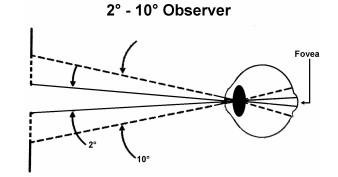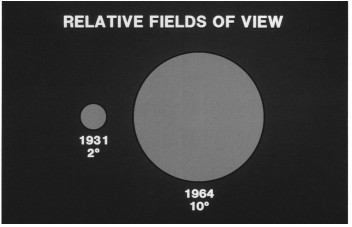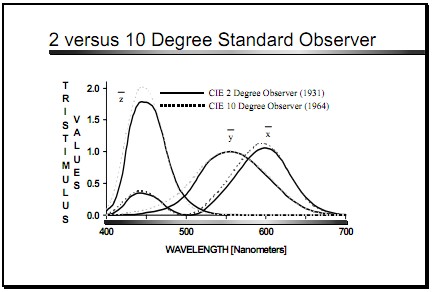CIE Standard Observers
2014-06-12
In the visual observing situation, the observer is the human eye that receives the light reflected from or transmitted through an object, and the brain which perceives the vision.

The visual observing situation
Since different humans perceive color and appearance in different ways, subjectively, attempts have been made to “standardize” the human observer as a numerical representation of what the “average person” sees. This standard observer could then be used in lieu of a human observer when assessments are made instrumentally.
Wright and Guild performed experiments using human volunteers to assess their color vision and develop an average, or standard, observer. In 1931 they published the 2° CIE Standard Observer function based on their research. The function is called 2° because their experiments involved having the subjects judge colors while looking through a hole that allowed them a 2° field of view. In 1931, it was believed that all the color-sensing cones of the eye were located within a 2° arc of the fovea. Thus the 2° field of view was chosen and used in establishing the standard observer.

By the 1960s, it was realized that cones were present in a larger area of the eye than previously believed, and so in 1964, the 10° Standard Observer was developed. The 10° Standard Observer is currently believed to best represent the average spectral response of human observers, although the 2° Standard Observer still has its place for measurement of objects that will be viewed at a distance, such as road signs. The relative sizes of the two fields of view are shown below.

The standard observers, in the form of mathematical functions of the human response to each wavelength of light, are used in color calculations. The observers can be graphed as shown below.

The CIE Tristimulus XYZ color scale, for instance, is calculated as follows:

where
R = % reflectance
T = % transmittance
Sums are across the spectral range for which the instrument reads.
Note that X, Y, and Z include factors for the mathematical standard observer in their formulas. All other tristimulus color scales (such as Hunter L, a, b and CIEL*a*b*) may then be calculated from XYZ.
---------------------------------------------------From Hunterlab
next:none prev:none
